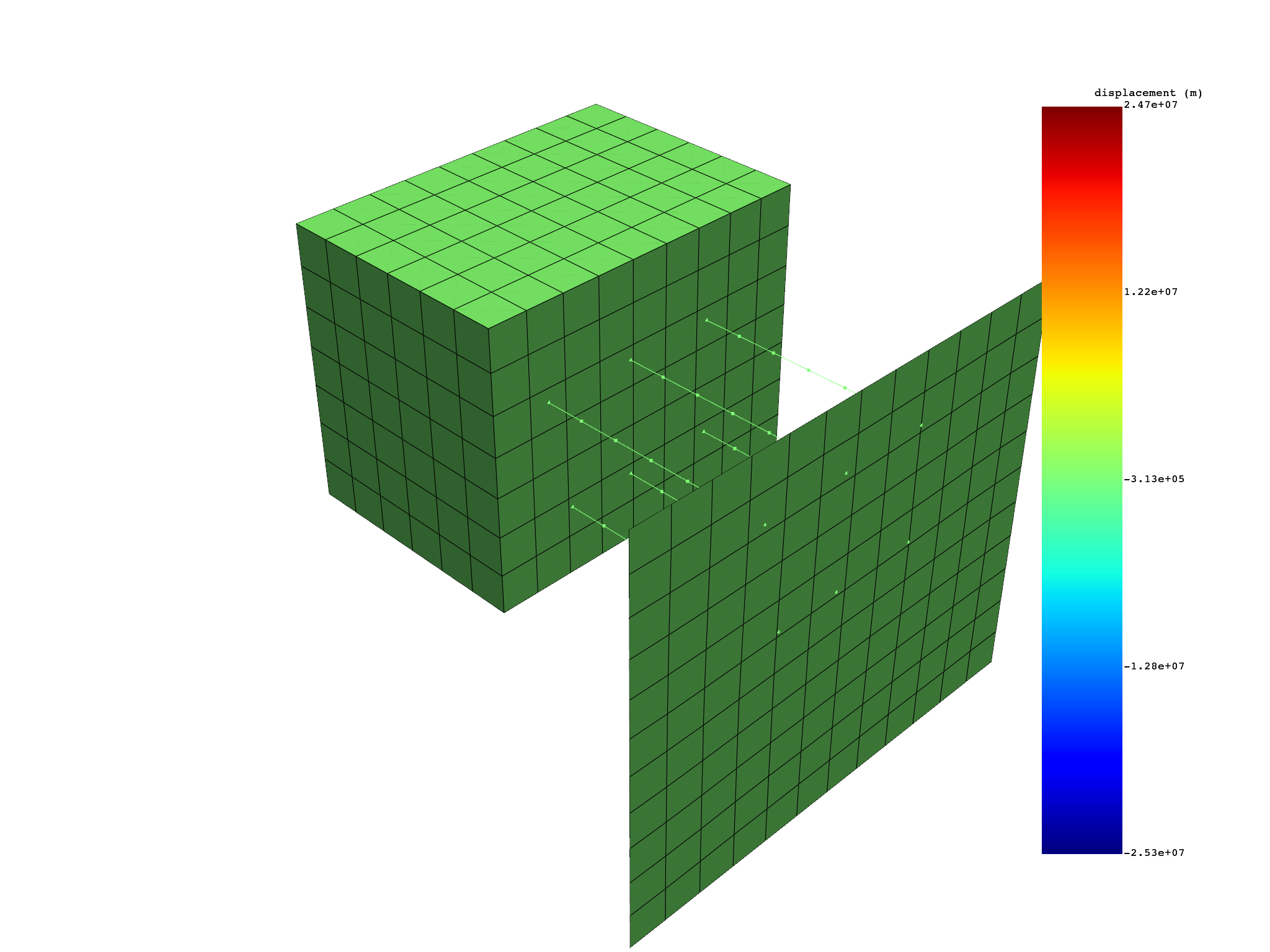Note
Go to the end to download the full example code.
Extract components of results (modal simulation)#
This example processes a modal simulation to extract subcomponents of results like displacement and elastic strain.
Perform required imports#
This example uses a supplied file that you can get by importing the DPF examples
package.
from ansys.dpf import post
from ansys.dpf.post import examples
Get Simulation object#
Get the Simulation object that allows access to the result. The Simulation
object must be instantiated with the path for the result file. For example,
"C:/Users/user/my_result.rst" on Windows or "/home/user/my_result.rst"
on Linux.
example_path = examples.download_all_kinds_of_complexity_modal()
# to automatically detect the simulation type, use:
simulation = post.load_simulation(example_path)
# to enable auto-completion, use the equivalent:
simulation = post.ModalMechanicalSimulation(example_path)
# print the simulation to get an overview of what's available
print(simulation)
Modal Mechanical Simulation.
Data Sources
------------------------------
/opt/hostedtoolcache/Python/3.10.18/x64/lib/python3.10/site-packages/ansys/dpf/core/examples/result_files/testing/modal_allKindOfComplexity.rst
DPF Model
------------------------------
Modal analysis
Unit system: MKS: m, kg, N, s, V, A, degC
Physics Type: Mechanical
Available results:
- displacement: Nodal Displacement
- reaction_force: Nodal Force
- smisc: Elemental Elemental Summable Miscellaneous Data
- element_nodal_forces: ElementalNodal Element nodal Forces
- stress: ElementalNodal Stress
- elemental_volume: Elemental Volume
- stiffness_matrix_energy: Elemental Energy-stiffness matrix
- artificial_hourglass_energy: Elemental Hourglass Energy
- kinetic_energy: Elemental Kinetic Energy
- co_energy: Elemental co-energy
- incremental_energy: Elemental incremental energy
- thermal_dissipation_energy: Elemental thermal dissipation energy
- elastic_strain: ElementalNodal Strain
- elastic_strain_eqv: ElementalNodal Strain eqv
- element_orientations: ElementalNodal Element Euler Angles
- nmisc: Elemental Elemental Non Summable Miscellaneous Data
- structural_temperature: ElementalNodal Structural temperature
------------------------------
DPF Meshed Region:
2388 nodes
1836 elements
Unit: m
With solid (3D) elements, shell (2D) elements, shell (3D) elements, beam (1D) elements
------------------------------
DPF Time/Freq Support:
Number of sets: 45
Cumulative Frequency (Hz) LoadStep Substep
1 4800.665229 1 1
2 6472.119402 1 2
3 10094.813112 1 3
4 15408.070193 1 4
5 19935.616102 1 5
6 30659.224027 1 6
7 33485.028985 1 7
8 40514.020302 1 8
9 41144.836724 1 9
10 41696.364343 1 10
11 42568.142453 1 11
12 48803.935725 1 12
13 51557.014600 1 13
14 54829.807966 1 14
15 55121.065060 1 15
16 55481.661956 1 16
17 55779.054274 1 17
18 56346.453210 1 18
19 56598.396154 1 19
20 57504.056787 1 20
21 57768.209089 1 21
22 60135.893137 1 22
23 62336.016111 1 23
24 62809.029190 1 24
25 64186.171203 1 25
26 64911.479227 1 26
27 66488.724651 1 27
28 66728.182829 1 28
29 67521.333063 1 29
30 68699.230845 1 30
31 70108.268581 1 31
32 71432.124756 1 32
33 71784.765113 1 33
34 73189.275762 1 34
35 74862.553459 1 35
36 75051.318416 1 36
37 76335.025905 1 37
38 76631.728520 1 38
39 76956.786796 1 39
40 77754.144888 1 40
41 78460.122703 1 41
42 78721.878185 1 42
43 79330.520798 1 43
44 80301.992725 1 44
45 80835.840814 1 45
Extract X displacement over a list modes#
To help pick the right modes, printing the time frequency support.
print(simulation.time_freq_support)
# To get X displacements on the first two modes
x_displacement = simulation.displacement(modes=[1, 2], components=["X"])
# equivalent to
x_displacement = simulation.displacement(set_ids=[1, 2], components=["X"])
print(x_displacement)
x_displacement.plot(set_id=1)

DPF Time/Freq Support:
Number of sets: 45
Cumulative Frequency (Hz) LoadStep Substep
1 4800.665229 1 1
2 6472.119402 1 2
3 10094.813112 1 3
4 15408.070193 1 4
5 19935.616102 1 5
6 30659.224027 1 6
7 33485.028985 1 7
8 40514.020302 1 8
9 41144.836724 1 9
10 41696.364343 1 10
11 42568.142453 1 11
12 48803.935725 1 12
13 51557.014600 1 13
14 54829.807966 1 14
15 55121.065060 1 15
16 55481.661956 1 16
17 55779.054274 1 17
18 56346.453210 1 18
19 56598.396154 1 19
20 57504.056787 1 20
21 57768.209089 1 21
22 60135.893137 1 22
23 62336.016111 1 23
24 62809.029190 1 24
25 64186.171203 1 25
26 64911.479227 1 26
27 66488.724651 1 27
28 66728.182829 1 28
29 67521.333063 1 29
30 68699.230845 1 30
31 70108.268581 1 31
32 71432.124756 1 32
33 71784.765113 1 33
34 73189.275762 1 34
35 74862.553459 1 35
36 75051.318416 1 36
37 76335.025905 1 37
38 76631.728520 1 38
39 76956.786796 1 39
40 77754.144888 1 40
41 78460.122703 1 41
42 78721.878185 1 42
43 79330.520798 1 43
44 80301.992725 1 44
45 80835.840814 1 45
results U_X (m)
set_ids 1 2
node_ids
289 -1.1710e+00 3.0726e+00
573 -1.6975e+00 3.1432e+00
589 -2.2447e+00 3.3385e+00
591 -1.5945e+00 3.6033e+00
324 0.0000e+00 0.0000e+00
579 0.0000e+00 0.0000e+00
... ... ...
(None, <pyvista.plotting.plotter.Plotter object at 0x7fbb605f7be0>)
Extract XX and XY elastic strain over a list modes#
Get X displacements on the first two modes.
XX_XY_elastic_strain = simulation.elastic_strain_nodal(
modes=[3], components=["XX", "XY"]
)
print(XX_XY_elastic_strain)
results EPEL
set_ids 3
elshape 1
node_ids components
79 XX
XY
598 XX
XY
487 XX
XY
... ... ...
Total running time of the script: (0 minutes 1.364 seconds)

